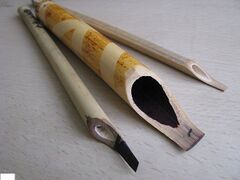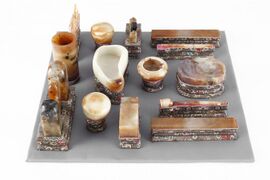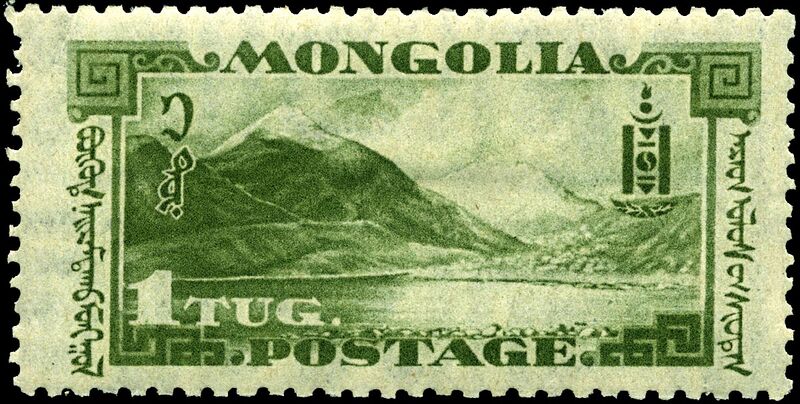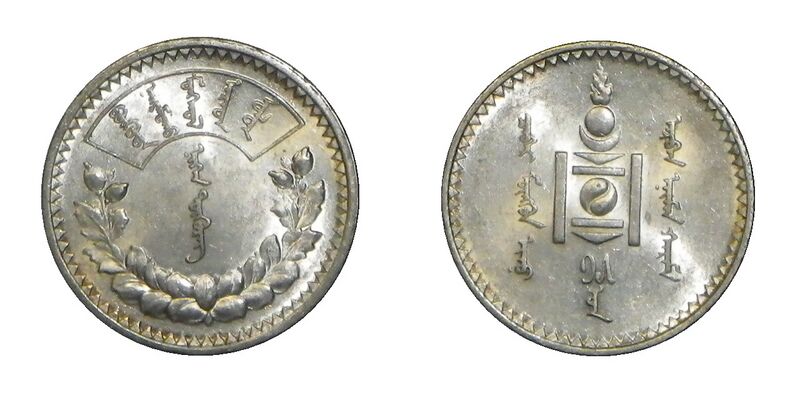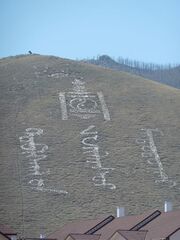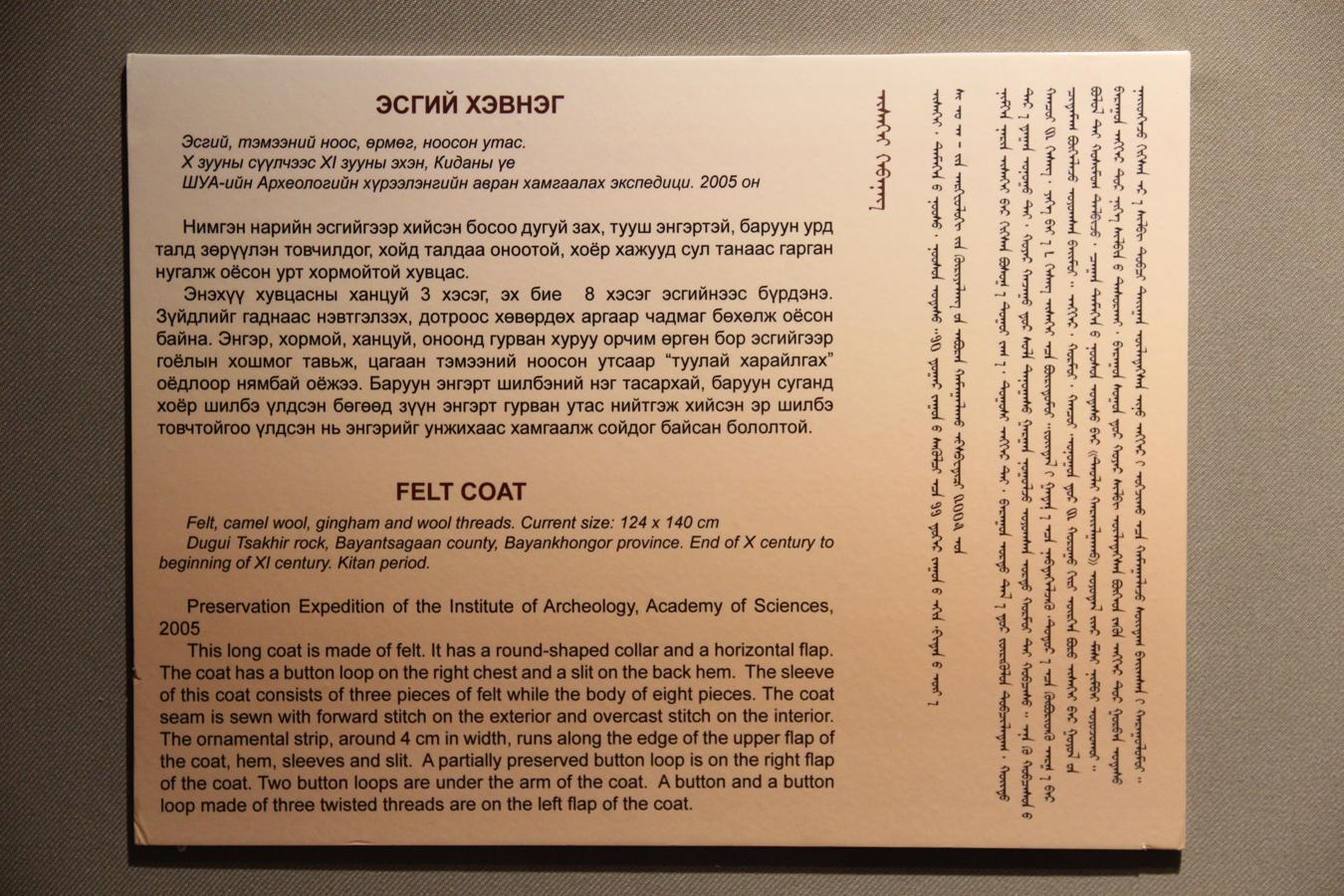Social:Mongolian script
| Mongolian script ᠮᠣᠩᠭᠣᠯ ᠪᠢᠴᠢᠭ | |
|---|---|
 A poem by Injinash | |
| Type | |
| Languages | Mongolian language |
| Creator | Tata-tonga |
Time period | c. 1204 – 1941 (used as main script) 1941 – Present (used as co script) |
Parent systems | Egyptian hieroglyphs
|
Child systems | Manchu alphabet
Oirat alphabet (Clear script) Buryat alphabet Galik alphabet Evenki alphabet |
| Direction | Top-to-bottom |
| ISO 15924 | Mong, 145 |
Unicode alias | Mongolian |
| |
The traditional Mongolian script,[note 1] also known as the Hudum Mongol bichig,[note 2] was the first writing system created specifically for the Mongolian language, and was the most widespread until the introduction of Cyrillic in 1946. It is traditionally written in vertical lines Template:TextDir. Derived from the Old Uyghur alphabet, it is a true alphabet, with separate letters for consonants and vowels. It has been adapted for such languages as Oirat and Manchu. Alphabets based on this classical vertical script continue to be used in Mongolia and Inner Mongolia to write Mongolian, Xibe and, experimentally, Evenki.
Computer operating systems have been slow to adopt support for Mongolian script; almost all have incomplete support or other text rendering difficulties.
History
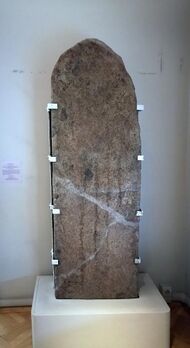
The Mongolian vertical script developed as an adaptation of the Old Uyghur alphabet for the Mongolian language.[2](p545) Tata-tonga, a 13th-century Uyghur scribe captured by Genghis Khan, was responsible for bringing the Old Uyghur alphabet to the Mongolian Plateau and adapting it to the form of the Mongolian script.[3]
From the seventh and eighth to the fifteenth and sixteenth centuries, the Mongolian language separated into southern, eastern and western dialects. The principal documents from the period of the Middle Mongol language are: in the eastern dialect, the famous text The Secret History of the Mongols, monuments in the Square script, materials of the Chinese–Mongolian glossary of the fourteenth century and materials of the Mongolian language of the middle period in Chinese transcription, etc.; in the western dialect, materials of the Arab–Mongolian and Persian–Mongolian dictionaries, Mongolian texts in Arabic transcription, etc.[4](pp1–2) The main features of the period are that the vowels ï and i had lost their phonemic significance, creating the i phoneme (in the Chakhar dialect, the Standard Mongolian in Inner Mongolia, these vowels are still distinct); inter-vocal consonants γ/g, b/w had disappeared and the preliminary process of the formation of Mongolian long vowels had begun; the initial h was preserved in many words; grammatical categories were partially absent, etc. The development over this period explains why the Mongolian script looks like a vertical Arabic script (in particular the presence of the dot system).[4](pp1–2)
Eventually, minor concessions were made to the differences between the Uyghur and Mongol languages: In the 17th and 18th centuries, smoother and more angular versions of the letter tsadi became associated with [dʒ] and [tʃ] respectively, and in the 19th century, the Manchu hooked yodh was adopted for initial [j]. Zain was dropped as it was redundant for [s]. Various schools of orthography, some using diacritics, were developed to avoid ambiguity.[2](p545)
Traditional Mongolian is written vertically from top to bottom, flowing in lines from left to right. The Old Uyghur script and its descendants, of which traditional Mongolian is one among Oirat Clear, Manchu, and Buryat are the only known vertical scripts written from left to right. This developed because the Uyghurs rotated their Sogdian-derived script, originally written right to left, 90 degrees counterclockwise to emulate Chinese writing, but without changing the relative orientation of the letters.[5][1](p36)
The reed pen was the writing instrument of choice until the 18th century, when the brush took its place under Chinese influence.[6](p422) Pens were also historically made of wood, bamboo, bone, bronze, or iron. Ink used was black or cinnabar red, and written with on birch bark, paper, cloths made of silk or cotton, and wooden or silver plates.[7](pp80–81)
-
Reed pens
-
Ink brushes
-
Writing implements of the Bogd Khan
Mongols learned their script as a syllabary, dividing the syllables into twelve different classes, based on the final phonemes of the syllables, all of which ended in vowels.[8]
The script remained in continuous use by Mongolian speakers in Inner Mongolia in the People's Republic of China. In the Mongolian People's Republic, it was largely replaced by the Mongolian Cyrillic alphabet, although the vertical script remained in limited use. In March 2020, the Mongolian government announced plans to increase the use of the traditional Mongolian script and to use both Cyrillic and Mongolian script in official documents by 2025.[9][10][11] However, due to the particularity of the traditional Mongolian script, a large part (40%[12]) of the Sinicized Mongols in China are unable to read or write this script, and in many cases the script is only used symbolically on plaques in many cities.[13][14]
Names
The script is known by a wide variety of names. As it was derived from the Old Uyghur alphabet, the Mongol script is known as the Uighur(-)Mongol script.[note 3] From 1941 onwards, it became known as the Old Script,[note 4] in contrast to the New Script,[note 5] referring to Cyrillic. The Mongolian script is also known as the Hudum or 'not exact' script,[note 6] in comparison with the Todo 'clear, exact' script,[note 7] and also as 'vertical script'.[note 8][15](p308)[1](pp30–32, 38–39)[16](p640)[17](p7)[18][19](p206)[20](p27)[21]
Overview
The traditional or classical Mongolian alphabet, sometimes called Hudum 'traditional' in Oirat in contrast to the Clear script (Todo 'exact'), is the original form of the Mongolian script used to write the Mongolian language. It does not distinguish several vowels (o/u, ö/ü, final a/e) and consonants (syllable-initial t/d and k/g, sometimes ǰ/y) that were not required for Uyghur, which was the source of the Mongol (or Uyghur-Mongol) script.[5] The result is somewhat comparable to the situation of English, which must represent ten or more vowels with only five letters and uses the digraph th for two distinct sounds. Ambiguity is sometimes prevented by context, as the requirements of vowel harmony and syllable sequence usually indicate the correct sound. Moreover, as there are few words with an exactly identical spelling, actual ambiguities are rare for a reader who knows the orthography.
Letters have different forms depending on their position in a word: initial, medial, or final. In some cases, additional graphic variants are selected for visual harmony with the subsequent character.
The rules for writing below apply specifically for the Mongolian language, unless stated otherwise.
Sort orders
- Traditional: n, q/k, γ/g, b, p, s, š, t, d, l, m, č...[22][23](p7)
- Modern: n, b, p, q/k, γ/g, m, l, s, š, t, d, č...[22][23](p7)
- Other modern orderings that apply to specific dictionaries also exist.[24]
Vowel harmony
Mongolian vowel harmony separates the vowels of words into three groups – two mutually exclusive and one neutral:
- The back, male, masculine,[25] hard, or yang[26] vowels a, o, and u.
- The front, female, feminine,[25] soft, or yin[26] vowels e, ö, and ü.
- The neutral vowel i, able to appear in all words.
Any Mongolian word can contain the neutral vowel i, but only vowels from either of the other two groups. The vowel qualities of visually separated vowels and suffixes must likewise harmonize with those of the preceding word stem. Such suffixes are written with front or neutral vowels when preceded by a word stem containing only neutral vowels. Any of these rules might not apply for foreign words however.[4](pp11, 35, 39)[27](p10)[28](p4)[24]
Separated final vowels
File:Mongolia police patch 03.tif
A separated final form of vowels a or e is common, and can appear at the end of a word stem, or suffix. This form requires a final-shaped preceding letter, and an inter-word gap in between. This gap can be transliterated with a hyphen.[note 9][4](pp30, 77)[29](p42)[1](pp38–39)[28](p27)[30](pp534–535)
The presence or lack of a separated a or e can also indicate differences in meaning between different words (compare ᠬᠠᠷTemplate:Mvsᠠ⟨?⟩ qar‑a 'black' with ᠬᠠᠷᠠ qara 'to look').[31](p3)[30](p535)
Its form could be confused with that of the identically shaped traditional dative-locative suffix ‑a/‑e exemplified further down. That form however, is more commonly found in older texts, and more commonly takes the forms of ⟨ᠲTemplate:Fvsᠤᠷ⟩ tur/tür or ⟨ᠳTemplate:Fvsᠤᠷ⟩ dur/dür instead.[27](p15)[32][1](p46)
Separated suffixes
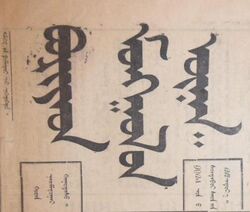
ᠪᠤᠷᠢᠶᠠᠳ ᠮᠣᠩᠭᠣᠯ ᠤᠨ ᠦᠨᠡᠨ᠃
Buriyad Mongγol‑un ünen 'Buryat-Mongol truth' with the suffix ᠤᠨ⟨?⟩ ‑un.
All case suffixes, as well as any plural suffixes consisting of one or two syllables, are likewise separated by a preceding and hyphen-transliterated gap.[note 10] A maximum of two case suffixes can be added to a stem.[4](pp30, 73)[27](p12)[32][33][28](p28)[30](p534)
Such single-letter vowel suffixes appear with the final-shaped forms of a/e, i, or u/ü,[4](p30) as in ᠭᠠᠵᠠᠷ ᠠ⟨?⟩ γaǰar‑a 'to the country' and ᠡᠳᠦᠷ ᠡ⟨?⟩ edür‑e 'on the day',[4](p39) or ᠤᠯᠤᠰ ᠢ⟨?⟩ ulus‑i 'the state' etc.[4](p23) Multi-letter suffixes most often start with an initial- (consonants), medial- (vowels), or variant-shaped form. Medial-shaped u in the two-letter suffix ᠤᠨ⟨?⟩ ‑un/‑ün is exemplified in the adjacent newspaper logo.[4](p30)[30](p27)
Consonant clusters
Two medial consonants are the most that can come together in original Mongolian words. There are however, a few loanwords that can begin or end with two or more.[note 11]
Compound names
In the modern language, proper names (but not words) usually forms graphic compounds (such as those of ᠬᠠᠰᠡᠷᠳᠡᠨᠢ Qas'erdeni 'Jasper-jewel' or ᠬᠥᠬᠡᠬᠣᠲᠠ Kökeqota – the city of Hohhot or 'Blue-city'). These also allow components of different harmonic classes to be joined together, and where the vowels of an added suffix will harmonize with those of the latter part of the compound. Orthographic peculiarities are most often retained, as with the short and long teeth of an initial-shaped ⟨ᠥ→ᠥTemplate:Fvs⟩ ö in ᠮᠤᠤᠥTemplate:Fvsᠬᠢᠨ Muu'ökin 'Bad Girl' (protective name). Medial t and d, in contrast, are not affected in this way.[4](p30)[35](p92)[1](p44)[17](p88)
Isolate citation forms
Isolate citation forms for syllables containing o, u, ö, and ü may in dictionaries appear without a final tail as in ⟨ᠪᠣ⟩ bo/bu or ⟨ᠮᠣTemplate:Fvs⟩ mo/mu, and with a vertical tail as in ⟨ᠪᠥTemplate:Fvs⟩ bö/bü or ⟨ᠮᠥTemplate:Fvs⟩ mö/mü (as well as in transcriptions of Chinese syllables).[24][1](p39)
Letters
Native Mongolian
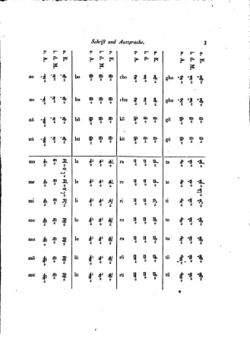
| Letters[4](pp17, 18) |
Contextual forms | Transliteration |
International Phonetic Alphabet | ||||
|---|---|---|---|---|---|---|---|
| Initial | Medial | Final | Latin | Cyrillic |
Khalkha |
Chakhar | |
| ᠠ | ᠠ | ᠠ | ᠠ | a | [а] Error: {{Transliteration}}: transliteration text not Latin script (pos 1: а) (help) | /a/ | /ɑ/ |
| ᠡ | ᠡ | ᠡ | ᠡ | e | [э] Error: {{Transliteration}}: transliteration text not Latin script (pos 1: э) (help) | /ə/ | |
| ᠢ | ᠢ | ᠢ | ᠢ | i | [и] Error: {{Transliteration}}: transliteration text not Latin script (pos 1: и) (help) | /i/ | /i/ or /ɪ/ |
| ᠣ | ᠣ | ᠣ | ᠣ | o | [о] Error: {{Transliteration}}: transliteration text not Latin script (pos 1: о) (help) | /ɔ/ | |
| ᠤ | ᠤ | ᠤ | ᠤ | u | [у] Error: {{Transliteration}}: transliteration text not Latin script (pos 1: у) (help) | /ʊ/ | |
| ᠥ | ᠥ | ᠥTemplate:Fvs
ᠥ |
ᠥ | ö | [ө] Error: {{Transliteration}}: transliteration text not Latin script (pos 1: ө) (help) | /ɵ/ | /o/ |
| ᠦ | ᠦ | ᠦTemplate:Fvs
ᠦ |
ᠦ | ü | [ү] Error: {{Transliteration}}: transliteration text not Latin script (pos 1: ү) (help) | /u/ | |
| ᠨ | ᠨ | ᠨ
ᠨTemplate:Fvs |
ᠨ | n | [н] Error: {{Transliteration}}: transliteration text not Latin script (pos 1: н) (help) | /n/ | |
| ᠩ | — | ᠩ | ᠩ | ng | [нг] Error: {{Transliteration}}: transliteration text not Latin script (pos 1: н) (help) | /ŋ/ | |
| ᠪ | ᠪ | ᠪ | ᠪ | b | [б] Error: {{Transliteration}}: transliteration text not Latin script (pos 1: б) (help) | /p/ and /w/ | /b/ |
| ᠫ | ᠫ | ᠫ | — | p | [п] Error: {{Transliteration}}: transliteration text not Latin script (pos 1: п) (help) | /pʰ/ | /p/ |
| ᠬ | ᠬ | ᠬ | ᠬ | q
k |
[х] Error: {{Transliteration}}: transliteration text not Latin script (pos 1: х) (help) | /x/ | |
| ᠭ | ᠭ | ᠭ
ᠭTemplate:Fvs |
ᠭ | ɣ
g |
[г] Error: {{Transliteration}}: transliteration text not Latin script (pos 1: г) (help) | /ɢ/ | /ɣ/ |
| ᠮ | ᠮ | ᠮ | ᠮ | m | [м] Error: {{Transliteration}}: transliteration text not Latin script (pos 1: м) (help) | /m/ | |
| ᠯ | ᠯ | ᠯ | ᠯ | l | [л] Error: {{Transliteration}}: transliteration text not Latin script (pos 1: л) (help) | /ɮ/ | /l/ |
| ᠰ | ᠰ | ᠰ | ᠰ | s | [с] Error: {{Transliteration}}: transliteration text not Latin script (pos 1: с) (help) | /s/ or /ʃ/ before i | |
| ᠱ | ᠱ | ᠱ | ᠱ | š | [ш] Error: {{Transliteration}}: transliteration text not Latin script (pos 1: ш) (help) | /ʃ/ | |
| ᠲ | ᠲ | ᠲ | — | t | [т] Error: {{Transliteration}}: transliteration text not Latin script (pos 1: т) (help) | /t/ | |
| ᠳ | ᠳ | ᠳ
ᠳTemplate:Fvs |
ᠳ | d | [д] Error: {{Transliteration}}: transliteration text not Latin script (pos 1: д) (help) | /t/ and /tʰ/ | /d/ |
| ᠴ | ᠴ | ᠴ | — | č | [ч] Error: {{Transliteration}}: transliteration text not Latin script (pos 1: ч) (help) | /t͡ʃʰ/ and /t͡sʰ/ | /t͡ʃ/ |
| ᠵ | ᠵ | ᠵ | — | ǰ | [ж] Error: {{Transliteration}}: transliteration text not Latin script (pos 1: ж) (help) | /d͡ʒ/ and d͡z | /d͡ʒ/ |
| ᠶ | ᠶ | ᠶ | ᠶ | y | [й] Error: {{Transliteration}}: transliteration text not Latin script (pos 1: й) (help) | /j/ | |
| ᠷ | ᠷ | ᠷ | ᠷ | r | [р] Error: {{Transliteration}}: transliteration text not Latin script (pos 1: р) (help) | /r/ | |
Galik characters
In 1587, the translator and scholar Ayuush Güüsh created the Galik alphabet (Али-гали Ali-gali), inspired by the third Dalai Lama, Sonam Gyatso. It primarily added extra characters for transcribing Tibetan and Sanskrit terms when translating religious texts, and later also from Chinese. Some of those characters are still in use today for writing foreign names (as listed below).[39]
In 1917, the politician and linguist Bayantömöriin Khaisan published the rime dictionary Mongolian-Han Bilingual Original Sounds of the Five Regions,[lower-alpha 1] a bilingual edition of the earlier Original Sounds of the Five Regions,[lower-alpha 2] to aid Mongolian speakers in learning Mandarin Chinese. To that end, he included transliterations of Mandarin using the Mongolian script, and repurposed three Galik letters to represent the Mandarin retroflex consonants. These letters remain in use in Inner Mongolia for the purpose of transcribing Chinese.[40]
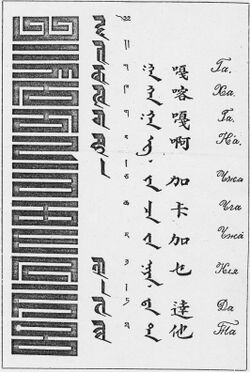
| Letters |
Contextual forms | Transliteration[note 12] |
IPA | |||||
|---|---|---|---|---|---|---|---|---|
| Initial | Medial | Final | Latin | Cyrillic |
Sanskrit | Tibetan | ||
| ᠧ | ᠧ | ᠧ | ᠧ | ē | [е] Error: {{Transliteration}}: transliteration text not Latin script (pos 1: е) (help) | ए | ཨེ | /e/ |
| ᠸ | ᠸ | ᠸ | ᠸ | w | [в] Error: {{Transliteration}}: transliteration text not Latin script (pos 1: в) (help) | व | ཝ | /w/ |
| ᠹ | ᠹ | ᠹ | ᠹ | f | [ф] Error: {{Transliteration}}: transliteration text not Latin script (pos 1: ф) (help) | ཕ | /f/ | |
| ᠺ | ᠺ | ᠺ | ᠺ | k | [к] Error: {{Transliteration}}: transliteration text not Latin script (pos 1: к) (help) | क | ག | /k/ |
| ᠻ | ᠻ | ᠻ | ᠻ | kh | [к] Error: {{Transliteration}}: transliteration text not Latin script (pos 1: к) (help) | ख | ཁ | /kʰ/ |
| ᠼ | ᠼ | ᠼ | ᠼ | c | [ц] Error: {{Transliteration}}: transliteration text not Latin script (pos 1: ц) (help) | छ | ཚ | /t͡s/ |
| ᠽ | ᠽ | ᠽ | ᠽ | z | [з] Error: {{Transliteration}}: transliteration text not Latin script (pos 1: з) (help) | ज | ཛ | /d͡z/ |
| ᠾ | ᠾ | ᠾ | ᠾ | h | [х] Error: {{Transliteration}}: transliteration text not Latin script (pos 1: х) (help) | ह | ཧ | /h/ |
| ᠿ | ᠿ | — | — | ž[lower-alpha 3] | [ж] Error: {{Transliteration}}: transliteration text not Latin script (pos 1: ж) (help) | ཞ | /ʐ/, /ɻ/[lower-alpha 4] | |
| ᡀ | ᡀ | — | — | lh[lower-alpha 5] | [лх] Error: {{Transliteration}}: transliteration text not Latin script (pos 1: л) (help) | ལྷ | /ɬ/ | |
| ᡁ | ᡁ | — | — | zh[lower-alpha 6] | [з] Error: {{Transliteration}}: transliteration text not Latin script (pos 1: з) (help) | /d͡ʐ/ | ||
| ᡂ | ᡂ | — | — | ch[lower-alpha 7] | [ч] Error: {{Transliteration}}: transliteration text not Latin script (pos 1: ч) (help) | ཋ | /t͡ʂ/ | |
- ↑ simplified Chinese: 《蒙汉合璧五方元音》; traditional Chinese: 《蒙漢合璧五方元音》
- ↑ Chinese: 《五方元音》
- ↑ Used in Inner Mongolia, and always followed by i. Only used to transcribe the Mandarin Chinese retroflex r, as in 日; rì: ᠿᠢ.
- ↑ Lee & Zee (2003) and Lin (2007) transcribe these as approximants, while Duanmu (2007) transcribes these as voiced fricatives. The actual pronunciation has been acoustically measured to be more approximant-like.[38][42]
- ↑ Only used in Tibetan loanwords to represent ལྷ syllables, such as in ᡀᠠᠰᠠ (“Lhasa”). Treated as a separate letter due to representing an independent phoneme, but can be analysed as a digraph of ᠯ (l) and ᠾ (h) (noting the latter is in medial position).
- ↑ Used in Inner Mongolia, and always followed by i. Only used to transcribe the Mandarin Chinese retroflex zh, as in 之; zhī: ᡁᠢ. Takes the form of medial h, but used in initial position.
- ↑ Used in Inner Mongolia, and always followed by i. Only used to transcribe the Mandarin Chinese retroflex ch, as in 蚩; chī: ᡂᠢ.
Punctuation and numerals
Punctuation

When written between words, punctuation marks use space on both sides of them. They can also appear at the very end of a line, regardless of where the preceding word ends.[35](p99) Red (cinnabar) ink is used in many manuscripts, to either symbolize emphasis or respect.[35](p241) Modern punctuation incorporates Western marks: parentheses; quotation, question, and exclamation marks; including precomposed ⁈ and ⁉.[30](pp535–536)
| Form(s) | Name | Function(s) |
|---|---|---|
| ᠀ | Birga[note 13] | Marks start of a book, chapter, passage, or first line |
| ᠀Template:Fvs | ||
| ᠀Template:Fvs | ||
| ᠀Template:Fvs | ||
| [...] | ||
| ᠂ | 'Dot'[note 14] | Comma |
| ᠃ | 'Double-dot'[note 15] | Period / full stop |
| ᠅ | 'Four-fold dot'[note 16] | Marks end of a passage, paragraph, or chapter |
| ᠁ | 'Dotted line'[note 17] | Ellipsis |
| ᠄ | Colon | |
| ᠆ | 'Spine, backbone'[note 18] | Mongolian soft hyphen (wikt:᠆) |
| ᠊ | Mongolian non-breaking hyphen, or stem extender (wikt:᠊) |
Numerals
| 15 on 'year of 15' on a 1925 tögrög coin, with the number written across the baseline.[44] | ᠑᠕ ᠣᠨ |
|
| 89 (top) written vertically on a hillside, with the number written on the baseline. | ᠘ ᠙ |
|
| Qančui 3, with the numeral rotated 90 degrees clockwise.[21] | ᠬᠠᠨᠴᠤᠢ ᠓ |
| 0 | 1 | 2 | 3 | 4 | 5 | 6 | 7 | 8 | 9 |
|---|---|---|---|---|---|---|---|---|---|
| ᠐ | ᠑ | ᠒ | ᠓ | ᠔ | ᠕ | ᠖ | ᠗ | ᠘ | ᠙ |
Mongolian numerals are either written from left to right, or from top to bottom.[4](p54)[37](p9) For typographical reasons, they are rotated 90° in modern books to fit on the line.[27](p56)
Components and writing styles
Components
Listed in the table below are letter components (graphemes)[note 19] commonly used across the script. Some of these are used with several letters, and others to contrast between them. As their forms and usage may differ between writing styles, however, examples of these can be found under this section below.
| Form | Name(s) | Use |
|---|---|---|
| ᠊ᠡ | 'Tooth'[note 20] | Main part of a and e (from Old Uyghur aleph), n and first part of ng (nun), q and γ (gimel-heth), m (mem), l (hooked resh), d and t (taw), etc. Historically also part of k and g (kaph), as well as r (resh). |
| 'Tooth'[note 21] | ||
| ᠡ | 'Crown'[note 22] | Exaggerated initial (swash) tooth. Used for the leading aleph of initial vowels (a, e, i, o, u, ö, ü, ē), and with some initial consonants (n , m, l, h = nun, mem, hooked resh, ha etc). |
| ᠊᠊ | 'Spine, backbone'[note 23] | The vertical line running through words. |
| ᠊ᠠ | 'Tail'[note 24] | The swash final of a, e, n, d, etc. |
| ᠊ᠰTemplate:Fvs | 'Short tail'[note 25] | The swash final of q and γ, m, and s (samekh-shin and zayin). |
| Template:Mvsᠠ⟨?⟩ ⟨ |
Crook[note 26] | Separated final a/e. |
| Crook, 'Sprinkling, dusting'[note 27] | Connected lower part of final a/e; the lower part of final (kaph) g. | |
| ᡳTemplate:Fvs | 'Hook'[note 28] | Lower part of final i (after bow-shaped b, k and g) and d. |
| ᠵ | 'Shin, stick'[note 29] | A main part of i, ǰ, and y, and final part of initial ö and ü (yodh); the upper part of final (kaph) g; etc. |
| 'Straight shin'[note 30] | ||
| 'Long tooth'[note 31] | ||
| ᠶ | 'Shin with upturn'[note 32] | Initial and medial y (yodh). |
| ᠸ | Shin with downturn[note 33] | Any ē and w (bet). |
| ᠷ | Horned shin[note 34] | Any r (resh). Historically also the upper part of final g and separated a/e. |
| ᠳTemplate:Fvs | 'Looped shin'[note 35] | Lamedh t and d. Historically with its enclosed (counter) endpoint varying in shape: open/closed, hook-shaped, pointy/round etc. |
| ᡁ | 'Hollow shin'[note 36] | Letters h and zh (from the Tibetan script) . |
| ᠢ | 'Bow'[note 37] | Final i, o–ü, and r; ng, b and p (pe), k and g, etc. |
| ᠊ᠣ | 'Belly, stomach,' loop, contour[note 38] | The counter of o–ü (waw), b, p, initial t and d, etc. |
| ᠲ | 'Hind-gut'[note 39] | Initial t and d. |
| ᠬ | [...][note 40] | Initial q and γ. |
| ᠊ᠮ | 'Braid, pigtail'[note 41] and 'Horn'[note 42] | Letters m and l. |
| ᠊ᠯ | ||
| ᠊ᠰ | 'Corner of the mouth'[note 43] | Letters s and š (samekh-shin). |
| ᠴ | [...][note 44] | The letter č (angular tsade). |
| 'Fork'[note 45] | ||
| ᠵ | [...][note 46] | The letter ǰ (smooth tsade). |
| 'Tusk, fang'[note 47] | ||
| ᠊ᠹ | Flaglet, tuft[note 48] | The left-side diacritic of f, z, etc. Names only used for such components created for foreign words . |
| ᠽ |
Writing styles
As exemplified in this section, the shapes of glyphs may vary widely between different styles of writing and choice of medium with which to produce them. The development of written Mongolian can be divided into the three periods of pre-classical (beginning – 17th century), classical (16/17th century – 20th century), and modern (20th century onward):[34][4](pp2–3, 17, 23, 25–26)[27](pp58–59)[2](pp539–540, 545–546)[37](pp62–63)[45](pp111, 113–114)[29](pp40–42, 100–101, 117)[1](pp34–37)[46](pp8–11)[19](pp211–215)
Rounded letterforms
- Rounded letterforms tend to be more prevalent with handwritten styles (compare printed and handwritten arban 'ten').
| Block‑printed | Pen-written form | Modern brush‑ |
Transliteration(s) & 'translation' | |
|---|---|---|---|---|
| Uyghur Mong. form | semi-modern forms | |||
| arban 'ten' | ||||
Tail
- Final letterforms with a right-pointing tail (such as those of a, e, n, q, γ, m, l, s, š, and d) may have the notch preceding it in printed form, written in a span between two extremes: from as a more or less tapered point, to a fully rounded curve in handwriting.
- The long final tails of a, e, n, and d in the texts of pre-classical Mongolian can become elongated vertically to fill up the remainder of a line. Such tails are used consistently for these letters in the earliest 13th to 15th century Uyghur Mongolian style of texts.
| Block‑printed | Pen-written forms | Modern brush‑ |
Transliteration(s) & 'translation' | |
|---|---|---|---|---|
| Uyghur Mong. forms | semi-modern forms | |||
| ‑ača/ | ||||
| ‑un/ | ||||
| ‑ud/ | ||||
| ba 'and' | ||||
Yodh
- A hooked form of yodh was borrowed from the Manchu alphabet in the 19th century to distinguish initial y from ǰ. The handwritten form of final-shaped yodh (i, ǰ, y), can be greatly shortened in comparison with its initial and medial forms.
| Block‑printed | Pen-written forms | Modern brush‑ |
Transliteration(s) & 'translation' | |
|---|---|---|---|---|
| Uyghur Mong. forms | semi-modern forms | |||
| ‑i | ||||
| ‑yi | ||||
| ‑yin | ||||
| sain/sayin 'good' | ||||
| yeke 'great' | ||||
Diacritics
- The definite status or function of diacritics was not established prior to classical Mongolian. As such, the dotted letters n, γ, and š, can be found sporadically dotted or altogether lacking them. Additionally, both q and γ could be (double-)dotted to identify them regardless of their sound values. Final dotted n is also found in modern Mongolian words. Any diacritical dots of γ and n can be offset downward from their respective letters (as in ᠭᠣᠣᠯ
 γool and ᠭᠦᠨ ᠢ⟨?⟩
γool and ᠭᠦᠨ ᠢ⟨?⟩  gün‑i).
gün‑i).
Bow
- When a bow-shaped consonant is followed by a vowel in Uyghur style text, said bow can be found to notably overlap it (see bi). A final b has, in its final pre-modern form, a bow-less final form as opposed to the common modern one:[1](p39)
| Block‑printed | Pen-written forms | Modern brush‑ |
Transliteration(s) & 'translation' | |
|---|---|---|---|---|
| Uyghur Mong. forms | semi-modern forms | |||
| ‑u/ | ||||
| bi 'I' | ||||
| ab (intensifying particle) | ||||
Gimel-heth and kaph
- As in kü, köke, ǰüg and separated a/e, two teeth can also make up the top-left part of a kaph (k/g) or aleph (a/e) in pre-classical texts. In back-vocalic words of Uyghur Mongolian, qi was used in place of ki, and can therefore be used to identify this stage of the written language. An example of this appears in the suffix
 ‑taqi/‑daqi.[29](pp100, 117)
‑taqi/‑daqi.[29](pp100, 117)
Ligatures

Short tail
- A pre-modern variant form for final s appears in the shape of a short final n ⟨ᠰTemplate:Fvs⟩, derived from Old Uyghur zayin (𐽴). It tended to be replaced by the mouth-shaped form and is no longer used. An early example of it is found in the name of Gengis Khan on the Stele of Yisüngge: ᠴᠢᠩᠭᠢᠰTemplate:Fvs Činggis. A zayin-shaped final can also appear as part of final m and γ.
| Block‑printed | Pen-written forms | Transliteration(s) & 'translation' | |
|---|---|---|---|
| Uyghur Mong. forms | semi-modern forms | ||
| es(‑)e 'not, no', (negation) | |||
| ulus 'nation' | |||
| nom 'book' | |||
| čaγ 'time' | |||
Taw and lamedh
- Initial taw (t/d) can, akin to final mem (m), be found written quite explicitly loopy (as in nom 'book' and toli 'mirror'). The lamedh (Lua error: Internal error: The interpreter has terminated with signal "24". or Lua error: Internal error: The interpreter has terminated with signal "24".) may appear simply as an oval loop or looped shin, or as more angular, with an either closed or open counter (as in Lua error: Internal error: The interpreter has terminated with signal "24"./Lua error: Internal error: The interpreter has terminated with signal "24". or Lua error: Internal error: The interpreter has terminated with signal "24"./Lua error: Internal error: The interpreter has terminated with signal "24".). As in Lua error: Internal error: The interpreter has terminated with signal "24"., a Uyghur style word-medial Lua error: Internal error: The interpreter has terminated with signal "24". can sometimes be written with the pre-consonantal form otherwise used for Lua error: Internal error: The interpreter has terminated with signal "24".. Taw was applied to both initial Lua error: Internal error: The interpreter has terminated with signal "24". and Lua error: Internal error: The interpreter has terminated with signal "24". from the outset of the script's adoption. This was done in imitation of Old Uyghur which, however, had lacked the phoneme Lua error: Internal error: The interpreter has terminated with signal "24". in this position.
Tsade
- Following the late classical Mongolian orthography of the 17th and 18th centuries, a smooth and angular tsade (ᠵ and ᠴ) has come to represent Lua error: Internal error: The interpreter has terminated with signal "24". and Lua error: Internal error: The interpreter has terminated with signal "24". respectively. The tsade before this was used for both these phonemes, regardless of graphical variants, as no Lua error: Internal error: The interpreter has terminated with signal "24". had existed in Old Uyghur:
Resh
- As in Lua error: Internal error: The interpreter has terminated with signal "24". and Lua error: Internal error: The interpreter has terminated with signal "24"./Lua error: Internal error: The interpreter has terminated with signal "24"., a resh (of Lua error: Internal error: The interpreter has terminated with signal "24"., and sometimes of Lua error: Internal error: The interpreter has terminated with signal "24".) can appear as two teeth or crossed shins; adjacent, angled, attached to a shin and/or overlapping.
Example
| Manuscript | Type | Unicode | Transliteration (first word) |
|---|---|---|---|

|

|
ᠸᠢᠺᠢᠫᠧᠳᠢᠶᠠ᠂ ᠴᠢᠯᠦᠭᠡᠲᠦ ᠨᠡᠪᠲᠡᠷᠬᠡᠢ ᠲᠣᠯᠢ ᠪᠢᠴᠢᠭ ᠪᠣᠯᠠᠢ᠃ |
ᠸᠢ Lua error: Internal error: The interpreter has terminated with signal "24"./ |
| ᠺᠢ Lua error: Internal error: The interpreter has terminated with signal "24"./Lua error: Internal error: The interpreter has terminated with signal "24". | |||
| ᠫᠧ Lua error: Internal error: The interpreter has terminated with signal "24"./Lua error: Internal error: The interpreter has terminated with signal "24". | |||
| ᠳᠢ Lua error: Internal error: The interpreter has terminated with signal "24". | |||
| ᠶTemplate:Mvsᠠ⟨?⟩ Lua error: Internal error: The interpreter has terminated with signal "24". or ᠶᠠ Lua error: Internal error: The interpreter has terminated with signal "24". | |||
| |||
Gallery
-
Mongolian calligraphy of the 13th century work Оюун Түлхүүр (Key of Intelligence)
-
Imperial seal of the Bogd Khan, ca 1911.
-
Mixed Manchu–Mongolian text on a Paiza.
-
Poem composed and brush-written by Injinash, 19th century
Unicode
The Mongolian script was added to the Unicode standard in September 1999 with the release of version 3.0. However, several design issues have been pointed out.[47]
- The 1999 Mongolian script Unicode codes are duplicated and not searchable.
- The 1999 Mongolian script Unicode model has multiple layers of FVS (free variation selectors), MVS, ZWJ, NNBSP, and those variation selections conflict with each other, which create incorrect results.[48] Furthermore, different vendors understood the definition of each FVS differently, and developed multiple applications in different standards.[49]
Blocks
The Unicode block for Mongolian is U+1800–U+18AF. It includes letters, digits and various punctuation marks for Hudum Mongolian, Todo Mongolian, Xibe (Manchu), Manchu proper, and Ali Gali, as well as extensions for transcribing Sanskrit and Tibetan.
The Mongolian Supplement block (U+11660–U+1167F) was added to the Unicode Standard in June 2016 with the release of version 9.0:
Keyboard layout
The Windows Mongolian traditional script keyboard layout for personal computers is as follows:[50]
Unshifted layout
| FVS3 | 1
᠑ |
2
᠒ |
3
᠓ |
4
᠔ |
5
᠕ |
6
᠖ |
7
᠗ |
8
᠘ |
9
᠙ |
0
᠐ |
NNBSP | = | Backspace | |||||||||||||||||||||||||||||
| Tab | Q
ᠴ Lua error: Internal error: The interpreter has terminated with signal "24". |
W
ᠣ Lua error: Internal error: The interpreter has terminated with signal "24". |
E
ᠡ Lua error: Internal error: The interpreter has terminated with signal "24". |
R
ᠷ Lua error: Internal error: The interpreter has terminated with signal "24". |
T
ᠲ Lua error: Internal error: The interpreter has terminated with signal "24". |
Y
ᠶ Lua error: Internal error: The interpreter has terminated with signal "24". |
U
ᠦ Lua error: Internal error: The interpreter has terminated with signal "24". |
I
ᠢ Lua error: Internal error: The interpreter has terminated with signal "24". |
O
ᠥ Lua error: Internal error: The interpreter has terminated with signal "24". |
P
ᠫ Lua error: Internal error: The interpreter has terminated with signal "24". |
(...)
〔 |
(...)
〕 |
(...)
᠁ | |||||||||||||||||||||||||||||
| Caps | A
ᠠ Lua error: Internal error: The interpreter has terminated with signal "24". |
S
ᠰ Lua error: Internal error: The interpreter has terminated with signal "24". |
D
ᠳ Lua error: Internal error: The interpreter has terminated with signal "24". |
F
ᠹ Lua error: Internal error: The interpreter has terminated with signal "24". |
G
ᠭ Lua error: Internal error: The interpreter has terminated with signal "24". |
H
ᠬ Lua error: Internal error: The interpreter has terminated with signal "24". |
J
ᠵ Lua error: Internal error: The interpreter has terminated with signal "24". |
K
ᠺ Lua error: Internal error: The interpreter has terminated with signal "24". |
L
ᠯ Lua error: Internal error: The interpreter has terminated with signal "24". |
;
︔ |
FVS1 | Enter | ||||||||||||||||||||||||||||||
| Shift | \ | Z
ᠽ Lua error: Internal error: The interpreter has terminated with signal "24". |
X
ᠱ Lua error: Internal error: The interpreter has terminated with signal "24". |
C
ᠼ Lua error: Internal error: The interpreter has terminated with signal "24". |
V
ᠤ Lua error: Internal error: The interpreter has terminated with signal "24". |
B
ᠪ Lua error: Internal error: The interpreter has terminated with signal "24". |
N
ᠨ Lua error: Internal error: The interpreter has terminated with signal "24". |
M
ᠮ Lua error: Internal error: The interpreter has terminated with signal "24". |
,
᠂ |
.
᠃ |
. | Shift | ||||||||||||||||||||||||||||||
| Ctrl | Alt | Alt | Ctrl | |||||||||||||||||||||||||||||||||||||||
Shifted layout
| ~ | 1
! |
2
⁈ |
3
⁉ |
4
— |
5
% |
6
ZWNJ |
7
᠊ |
8
ZWJ |
9
( |
0
) |
MVS | + | Backspace | |||||||||||||||||||||||||||||
| Tab | W
ᠸ Lua error: Internal error: The interpreter has terminated with signal "24". |
E
ᠧ Lua error: Internal error: The interpreter has terminated with signal "24". |
R
ᠿ Lua error: Internal error: The interpreter has terminated with signal "24". |
(...)
〈 |
(...)
〉 |
(...)
| | ||||||||||||||||||||||||||||||||||||
| Caps | H
ᠾ Lua error: Internal error: The interpreter has terminated with signal "24". |
K
ᠻ Lua error: Internal error: The interpreter has terminated with signal "24". |
L
ᡀ Lua error: Internal error: The interpreter has terminated with signal "24". |
:
᠄ |
FVS2 | Enter | ||||||||||||||||||||||||||||||||||||
| Shift | Z
ᡁ Lua error: Internal error: The interpreter has terminated with signal "24". |
C
ᡂ Lua error: Internal error: The interpreter has terminated with signal "24". |
N
ᠩ Lua error: Internal error: The interpreter has terminated with signal "24". |
,
《 |
.
》 |
? | Shift | |||||||||||||||||||||||||||||||||||
| Ctrl | Alt | Alt | Ctrl | |||||||||||||||||||||||||||||||||||||||
See also
- Mongolian writing systems
- Mongolian script
- Mongolian script multigraphs
- Galik alphabet
- Todo alphabet
- ʼPhags-pa script
- Soyombo script
- Mongolian Latin alphabet
- SASM/GNC romanization § Mongolian
- Mongolian Cyrillic alphabet
- Mongolian transliteration of Chinese characters
- Sino–Mongolian Transliterations (zh)
- Mongolian Braille
- Mongolian script
- Mongolian Sign Language
- Mongolian name
Notes
- ↑ In Mongolian script: ᠮᠣᠩᠭᠣᠯ ᠪᠢᠴᠢᠭ ⟨
 frameless⟩ mongγol bičig; in Mongolian Cyrillic: монгол бичиг mongol bichig
frameless⟩ mongγol bičig; in Mongolian Cyrillic: монгол бичиг mongol bichig
- ↑ In Mongolian script: ᠬᠤᠳᠤᠮ ᠮᠣᠩᠭᠣᠯ ᠪᠢᠴᠢᠭ qudum mongγol bičig; Khalkha: худам монгол бичиг, khudam mongol bichig; Buryat: Худам Монгол бэшэг, Hudam Mongol bèšèg; Kalmyk: Хуудм Моңһл бичг, Huudm Mon̦ḥl bičg[citation needed]
- ↑ ᠤᠶᠢᠭᠤᠷᠵᠢᠨ ᠮᠣᠩᠭᠣᠯ ᠪᠢᠴᠢᠭ uyiγurǰin mongγol bičig (уйгар/уйгаржин/уйгуржин монгол бичиг/үсэг uigar/uigarjin/uigurjin mongol bichig/üseg)
- ↑ ᠬᠠᠭᠤᠴᠢᠨ ᠪᠢᠴᠢᠭ qaγučin bičig (хуучин бичиг khuuchin bichig)
- ↑ ᠰᠢᠨᠡ/ᠰᠢᠨTemplate:Mvsᠡ ᠪᠢᠴᠢᠭ sine/sin‑e bičig (шинэ үсэг shine üseg)
- ↑ ᠬᠤᠳᠤᠮ ᠮᠣᠩᠭᠣᠯ ᠪᠢᠴᠢᠭ qudum mongγol bičig (худам монгол бичиг khudam mongol bichig)
- ↑ ᠲᠣᠳᠣ ᠪᠢᠴᠢᠭ/ᠦᠰᠦᠭ todo bičig/üsüg (тод бичиг/үсэг tod bichig/üseg)
- ↑ ᠪᠣᠱᠤᠭTemplate:Mvsᠠ ᠪᠢᠴᠢᠭ bošuγ-a bičig (босоо бичиг bosoo bichig)
- ↑ In digital typesetting, this shaping is achieved by inserting a U+180E MONGOLIAN VOWEL SEPARATOR (HTML
᠎·MVS) between the separated letters. - ↑ In digital typesetting, this shaping is achieved by inserting a U+202F NARROW NO-BREAK SPACE (HTML
 ·NNBSP) between the separated letters. - ↑ Examples of such include: (dotless š) gšan 'moment' (
 ), gkir 'dirt' (top, or bodisdv 'Bodhisattva' (
), gkir 'dirt' (top, or bodisdv 'Bodhisattva' ( ).[4](pp15, 32)[27](p9)[34](p385)
).[4](pp15, 32)[27](p9)[34](p385)
- ↑ 12.0 12.1 Scholarly/Scientific transliteration.[36]
- ↑ ᠪᠢᠷᠭTemplate:Mvsᠠ⟨?⟩ birγ‑a (бярга byarga)
- ↑ ᠴᠡᠭ čeg (цэг tseg)
- ↑ ᠳᠠᠪᠬᠤᠷ ᠴᠡᠭ dabqur čeg (давхар цэг davkhar tseg)
- ↑ ᠳᠥᠷᠪᠡᠯᠵᠢᠨ ᠴᠡᠭ dörbelǰin čeg (дөрвөлжин цэг dörvöljin tseg)
- ↑ ᠴᠤᠪᠠᠭTemplate:Mvsᠠ/ᠴᠤᠪᠤᠭTemplate:Mvsᠠ⟨?⟩ ᠴᠡᠭ čubaγ‑a/čubuγ‑a čeg (цуваа цэг tsuvaa tseg)
- ↑ ᠨᠢᠷᠤᠭᠤ niruγu (нуруу nuruu)
- ↑ Mongolian: ᠵᠢᠷᠤᠯᠭTemplate:Mvsᠠ⟨?⟩ ǰirulγ‑a / зурлага zurlaga
- ↑ ᠠᠴᠤᠭ ačuγ (ацаг atsag)
- ↑ ᠰᠢᠳᠦ sidü (шүд shüd)
- ↑ ᠲᠢᠲᠢᠮ titim (тит(и/э)м tit(i/e)m)
- ↑ ᠨᠢᠷᠤᠭᠤ niruγu (нуруу nuruu)
- ↑ ᠰᠡᠭᠦᠯ segül (сүүл süül)
- ↑ ᠪᠣᠭᠤᠨᠢ ᠰᠡᠭᠦᠯ boγuni segül (богино/богонь сүүл bogino/bogoni süül)
- ↑ ᠣᠷᠬᠢᠴᠠ orkiča (орхиц orkhits)
- ↑ ᠴᠠᠴᠤᠯᠭTemplate:Mvsᠠ⟨?⟩ čačulγ‑a (цацлага tsatslaga)
- ↑ ᠳᠡᠭᠡᠭᠡ degege (дэгээ degee)
- ↑ ᠰᠢᠯᠪᠢ silbi (шилбэ shilbe)
- ↑ ᠰᠢᠯᠤᠭᠤᠨ ᠰᠢᠯᠪᠢ siluγun silbi (шулуун шилбэ shuluun shilbe)
- ↑ ᠤᠷᠲᠤ ᠰᠢᠳᠦ urtu sidü (урт шүд urt shüd)
- ↑ ᠡᠭᠡᠲᠡᠭᠡᠷ ᠰᠢᠯᠪᠢ egeteger silbi (э(э)тгэр шилбэ e(e)tger shilbe)
- ↑ ᠮᠠᠲᠠᠭᠠᠷ ᠰᠢᠯᠪᠢ mataγar silbi (матгар шилбэ matgar shilbe)
- ↑ ᠥᠷᠭᠡᠰᠦᠲᠡᠢ ᠰᠢᠯᠪᠢ örgesütei silbi (өргөстэй шилбэ örgöstei shilbe)
- ↑ ᠭᠣᠭᠴᠤᠭᠠᠲᠠᠢ ᠰᠢᠯᠪᠢ γoγčuγatai silbi (гогцоотой шилбэ gogtsootoi shilbe)
- ↑ ᠬᠥᠨᠳᠡᠢ ᠰᠢᠯᠪᠢ köndei silbi (хөндий шилбэ khöndii shilbe)
- ↑ ᠨᠤᠮᠤ numu (нум num)
- ↑ ᠭᠡᠳᠡᠰᠦ gedesü (гэдэс gedes)
- ↑ ᠠᠷᠤ ᠶᠢᠨ ᠭᠡᠳᠡᠰᠦ⟨?⟩ aru‑yin gedesü (арын гэдэс aryn gedes)
- ↑ [...] (ятгар зартиг yatgar zartig)
- ↑ ᠭᠡᠵᠢᠭᠡ geǰige (гэзэг gezeg)
- ↑ ᠡᠪᠡᠷ eber (эвэр ever)
- ↑ ᠵᠠᠪᠠᠵᠢ ǰabaǰi (зав(и/ь)ж zavij)
- ↑ ᠰᠡᠷᠡᠭᠡ ᠡᠪᠡᠷ serege eber (сэрээ эвэр seree ever)
- ↑ ᠠᠴᠠ ača (ац ats)
- ↑ [...] (жалжгар эвэр jaljgar ever)
- ↑ ᠰᠣᠶᠤᠭTemplate:Mvsᠠ⟨?⟩ soyuγ‑a (соёо soyoo)
- ↑ ᠵᠠᠷᠲᠢᠭ ǰartiγ (зартиг zartig Wylie: 'jar-thig)
Lua error: Internal error: The interpreter has terminated with signal "24".
References
- ↑ 1.0 1.1 1.2 1.3 1.4 1.5 1.6 1.7 1.8 Janhunen, Juha (2006-01-27) (in en). The Mongolic Languages. Routledge. ISBN 978-1-135-79690-7. https://books.google.com/books?id=DuCRAgAAQBAJ.
- ↑ 2.0 2.1 2.2 2.3 2.4 Daniels, Peter T.; Bright, William (1996) (in en). The World's Writing Systems. Oxford University Press. ISBN 978-0-19-507993-7. https://books.google.com/books?id=ospMAgAAQBAJ&pg=PA545.
- ↑ Christian, David (1998). A History of Russia, Central Asia and Mongolia: Inner Eurasia from Prehistory to the Mongol Empire. Wiley. p. 398. ISBN 978-0-631-20814-3. https://books.google.com/books?id=YLQW5lUajgkC&pg=PA398.
- ↑ 4.00 4.01 4.02 4.03 4.04 4.05 4.06 4.07 4.08 4.09 4.10 4.11 4.12 4.13 4.14 4.15 4.16 Poppe, Nicholas (1974) (in en). Grammar of Written Mongolian. Otto Harrassowitz Verlag. ISBN 978-3-447-00684-2. https://archive.org/details/poppegrammarofwrittenmongolian1974/page/n1/mode/1up.
- ↑ 5.0 5.1 György Kara, "Aramaic Scripts for Altaic Languages", in Daniels & Bright The World's Writing Systems, 1994.
- ↑ Shepherd, Margaret (2013-07-03) (in en). Learn World Calligraphy: Discover African, Arabic, Chinese, Ethiopic, Greek, Hebrew, Indian, Japanese, Korean, Mongolian, Russian, Thai, Tibetan Calligraphy, and Beyond. Clarkson Potter/Ten Speed. ISBN 978-0-8230-8230-8. https://books.google.com/books?id=UZhGza8C77kC&pg=PT419.
- ↑ Berkwitz, Stephen C.; Schober, Juliane; Brown, Claudia (2009-01-13) (in en). Buddhist Manuscript Cultures: Knowledge, Ritual, and Art. Routledge. ISBN 978-1-134-00242-9. https://books.google.com/books?id=KvsLBf3jISAC&pg=PA80.
- ↑ Chinggeltei. (1963) A Grammar of the Mongol Language. New York, Frederick Ungar Publishing Co. p. 15.
- ↑ "Mongolia to promote usage of traditional script". http://www.china.org.cn/arts/2020-03/19/content_75834583.htm.
- ↑ Official documents to be recorded in both scripts from 2025, Montsame, 18 March 2020.
- ↑ Mongolian Language Law is effective from July 1st, Gogo, 1 July 2015. "Misinterpretation 1: Use of cyrillic is to be terminated and only Mongolian script to be used. There is no provision in the law that states the termination of use of cyrillic. It clearly states that Mongolian script is to be added to the current use of cyrillic. Mongolian script will be introduced in stages and state and local government is to conduct their correspondence in both cyrillic and Mongolian script. This provision is to be effective starting January 1st of 2025. ID, birth certificate, marriage certificate and education certificates are to be both in Mongolian cyrillic and Mongolian script and currently Mongolian script is being used in official letters of President, Prime Minister and Speaker of Parliament."
- ↑ 藍美華. 近期內蒙古漢語教材抗爭事件觀察. Mainland Affairs Council. https://ws.mac.gov.tw/Download.ashx?u=LzAwMS9VcGxvYWQvMjk1L2NrZmlsZS85ZDc1NjVlMi00NGY0LTRhNDgtYjkwZC1iMWVmMDAzN2U2YjcucGRm&n=5Zub44CB6JeN576O6I%2BvLS3ov5HmnJ%2Flhafokpnlj6TmvKLoqp7mlZnmnZDmipfniK3kuovku7bop4Dlr58ucGRm. Retrieved 2023-01-19.
- ↑ Caodaobateer (2004). "The Use and Development of Mongol and its Writing Systems in China". Language Policy in the People's Republic of China. Language Policy 4: 289–302. doi:10.1007/1-4020-8039-5_16. ISBN 1-4020-8038-7. https://link.springer.com/chapter/10.1007/1-4020-8039-5_16.
- ↑ "Ethnopolitics in modern China: the Nationalists, Muslims, and Mongols in wartime Alashaa Banner (1937–1945)". Stanford, CA, US: Hoover Institution, Stanford University. https://ru4.ilovetranslation.com/jhLk6JJ3SWl=d/.
- ↑ Hersch, Roger; Andre, Jacques; Brown, Heather (1998-03-18) (in en). EP '98. Springer Science & Business Media. ISBN 978-3-540-64298-5. https://books.google.com/books?id=bo453EDNBp4C&pg=PA308.
- ↑ Sanders, Alan J. K. (2010-05-20) (in en). Historical Dictionary of Mongolia. Scarecrow Press. ISBN 978-0-8108-7452-7. https://books.google.com/books?id=5JN83EDDLl4C.
- ↑ 17.0 17.1 Janhunen, Juha A. (2012) (in en). Mongolian. John Benjamins Publishing. ISBN 978-90-272-3820-7. https://books.google.com/books?id=SAlwcg9ioPMC.
- ↑ Bawden, Charles (2013-10-28) (in en). Mongolian English Dictionary. Routledge. ISBN 978-1-136-15595-6. https://books.google.com/books?id=6UfYAQAAQBAJ.
- ↑ 19.0 19.1 Cite error: Invalid
<ref>tag; no text was provided for refs namedSanders2015 - ↑ Marzluf, Phillip P. (2017-11-22) (in en). Language, Literacy, and Social Change in Mongolia: Traditionalist, Socialist, and Post-Socialist Identities. Lexington Books. ISBN 978-1-4985-3486-4. https://books.google.com/books?id=2To8DwAAQBAJ.
- ↑ 21.0 21.1 21.2 Cite error: Invalid
<ref>tag; no text was provided for refs namedMnToli - ↑ 22.0 22.1 "Unicode Technical Report #2". http://www.unicode.org/reports/tr2.html.
- ↑ 23.0 23.1 Cite error: Invalid
<ref>tag; no text was provided for refs namedLuvsandorj2008 - ↑ 24.0 24.1 24.2 24.3 "Mongolian Traditional Script". http://cjvlang.com/Writing/writmongol/index.html.
- ↑ 25.0 25.1 by Manchu convention
- ↑ 26.0 26.1 in Inner Mongolia.
- ↑ 27.0 27.1 27.2 27.3 27.4 27.5 Grønbech, Kaare; Krueger, John Richard (1993) (in en). An Introduction to Classical (literary) Mongolian: Introduction, Grammar, Reader, Glossary. Otto Harrassowitz Verlag. ISBN 978-3-447-03298-8. https://books.google.com/books?id=0YanEBJXGRMC.
- ↑ 28.0 28.1 28.2 "A Study of Traditional Mongolian Script Encodings and Rendering: Use of Unicode in OpenType fonts". http://w.colips.org/journals/volume21/21.1.3-Biligsaikhan.pdf.
- ↑ 29.0 29.1 29.2 29.3 Svantesson, Jan-Olof; Tsendina, Anna; Karlsson, Anastasia; Franzen, Vivan (2005-02-10) (in en). The Phonology of Mongolian. OUP Oxford. ISBN 978-0-19-151461-6. https://books.google.com/books?id=hQVREAAAQBAJ.
- ↑ 30.0 30.1 30.2 30.3 30.4 30.5 "The Unicode® Standard Version 10.0 – Core Specification: South and Central Asia-II". https://www.unicode.org/versions/Unicode10.0.0/ch13.pdf.
- ↑ "Mongolian / ᠮᠣᠩᠭᠣᠯ Moŋġol". https://www.eki.ee/knab/lat/kblcmg2.pdf.
- ↑ 32.0 32.1 Viklund, Andreas. "Lingua Mongolia – Mongolian Grammar" (in en). http://www.linguamongolia.com/gram1.html.
- ↑ "PROPOSAL Encode Mongolian Suffix Connector (U+180F) To Replace Narrow Non-Breaking Space (U+202F)". https://www.unicode.org/L2/L2017/17036-mongolian-suffix.pdf.
- ↑ 34.0 34.1 34.2 Cite error: Invalid
<ref>tag; no text was provided for refs namedLessing1960 - ↑ 35.0 35.1 35.2 35.3 Cite error: Invalid
<ref>tag; no text was provided for refs namedKara2005 - ↑ 36.0 36.1 36.2 36.3 "Mongolian transliterations". https://transliteration.eki.ee/pdf/Mongolian.pdf.
- ↑ 37.0 37.1 37.2 37.3 Cite error: Invalid
<ref>tag; no text was provided for refs namedSkorodumova2000 - ↑ 38.0 38.1 "Writing | Study Mongolian" (in en-US). August 2013. http://www.studymongolian.net/lessons/basics/writing/.
- ↑ Chuluunbaatar, Otgonbayar (2008) (in de). Einführung in die mongolischen Schriften. Buske. ISBN 978-3-87548-500-4.
- ↑ Wu, Jiaye (2022). "Teaching Mandarin Pronunciation to Mongolian Learners in Early Republican Period China: The Case of the Mongolian Han Original Sounds of the Five Regions". in Nicola McLelland and Hui Zhao. Language Standardization and Language Variation in Multilingual Contexts. ISBN 978-1-80041-155-5.
- ↑ "BabelStone: Mongolian and Manchu Resources" (in zh). http://babelstone.co.uk/Mongolian/Resources.html.
- ↑ Lee-Kim, Sang-Im (2014), "Revisiting Mandarin 'apical vowels': An articulatory and acoustic study", Journal of the International Phonetic Association 44 (3): 261–282, doi:10.1017/s0025100314000267
- ↑ Cite error: Invalid
<ref>tag; no text was provided for refs namedShagdarsueren2001 - ↑ "Coins". 2006-03-09. http://www.mongolbank.mn/oldcoins.htm.
- ↑ Cite error: Invalid
<ref>tag; no text was provided for refs namedClauson2005 - ↑ "Exploring Mongolian Manuscript Collections in Russia and Beyond". https://www.manuscript-cultures.uni-hamburg.de/cal-details/images/Exploring_Mongolian_Manuscript_Collections_in_Russia_and_Beyond.pdf.
- ↑ Liang, Hai (23 Sep 2017). "Current problems in the Mongolian encoding". https://www.unicode.org/~lisa/mongoliandocs/mwg2-12Currentproblems-LiangHai.pdf.
- ↑ Anderson, Debbie (22 Sep 2018). "Mongolian Ad Hoc meeting summary". https://www.unicode.org/L2/L2018/18314-mongolian-ad-hoc.pdf.
- ↑ Moore, Lisa (27 Mar 2019). "Summary of MWG2 Outcomes and Goals for MWG3 Meeting". https://www.unicode.org/~lisa/mongolianwg3docs/mwg3-13SummaryOfMWG2GoalsForMWG3R3.pdf.
- ↑ jowilco. "Windows keyboard layouts - Globalization" (in en-us). https://docs.microsoft.com/en-us/globalization/windows-keyboard-layouts.
Lua error: Internal error: The interpreter has terminated with signal "24".
External links
Keyboards Mongolian script layout online
Summaries
- University of Vienna: Grammar of Written Mongolian by Nicholas POPPE Index
- CJVlang: Making Sense of the Traditional Mongolian Script
- StudyMongolian: Written forms with audio pronunciation
- The Silver Horde: Mongol Scripts
- Lingua Mongolia: Uighur-script Mongolian Resources
- Omniglot: Mongolian Alphabet (note: contains several table inaccuracies regarding glyphs and transliterations)
Studies
- (fr) Rémusat, Abel Récherches sur les langues tartares, Paris, 1820
Grammars
- (ru) Schmidt, Isaak Jakob, Грамматика монгольскaго языка (Grammatika mongolʹskago i︠a︡zyka), Saint-Petersburg, 1832
- (ru) Bobrovnikov, Aleksieĭ Aleksandrovich Грамматика монгольско-калмыцкого языка (Grammatika mongolʹsko-kalmyt͡skago i͡azyka), Kazan, 1849
- (de) Schmidt, Isaak Jakob, Grammatik der mongolischen Sprache, St. Petersburg, 1831
- (fr) Soulié, Charles Georges, Éléments de grammaire mongole (dialecte ordoss), Paris, 1903
- (it) Puini, Carlo, Elementi della grammatica mongolica, Firenze, 1878
Dictionaries
- (fr, ru) Kovalevskiĭ, Osip Mikhaĭlovich, Dictionnaire Mongol-Russe-Franca̧is, Volumes 1–3, Kazan 1844-46-49
- Bolor Dictionary
- Mongol toli dictionary: state dictionary of Mongolia
Transliteration
- University of Virginia: Transliteration Schemes For Mongolian Vertical Script
- Online tool for Mongolian script transliteration
- Automatic converter for Traditional Mongolian and Cyrillic Mongolian by the Computer College of Inner Mongolia University
Manuscripts
- Mongolian Manuscripts from Olon Süme – Yokohama Museum of EurAsian Cultures
- Digitised Mongolian manuscripts – The Royal Library, National Library of Denmark
- Mongolian texts – Digitales Turfan-Archiv, the Berlin-Brandenburg Academy of Sciences and Humanities
- Preservation of unique and historic newspapers printed in traditional Mongolian script between 1936–1945 – Endangered Archives Programme, British Library
Other
- Official Mongolian script version of the People's Daily Online
- Office of the President of Mongolia website in Mongolian script
- Tang, Didi (20 March 2020). "Mongolia abandons Soviet past by restoring alphabet". https://www.thetimes.co.uk/article/mongolia-abandons-soviet-past-by-restoring-alphabet-rsvcgqmxd.
Lua error: Internal error: The interpreter has terminated with signal "24".
Lua error: Internal error: The interpreter has terminated with signal "24".
